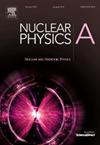在TRIUMF-ISAC的核反应实验
IF 2.5
4区 物理与天体物理
Q2 PHYSICS, NUCLEAR
引用次数: 0
摘要
TRIUMF的ISAC(同位素分离器和加速器)设施包含两个室温&;一个超导线性加速器能够提供从0.107到16.5 MeV/u的稀有同位素光束,使反应研究从远低于库仑势垒到远高于库仑势垒,进行聚变蒸发或高度外围转移反应。再加上一套实验设施,包括反冲分离器(DRAGON),反冲光谱仪(EMMA),康普顿抑制γ射线阵列(TIGRESS),电荷粒子散射装置(TUDA, SONIK, SHARC)和固体氢靶设施(IRIS),各种各样的核反应研究项目一直在进行。这些范围从核天体物理学的直接和间接截面(或寿命或分支比)测量,到滴线和反转岛附近的核壳演化研究,核配对,核晕,团簇或亚势垒融合增强研究。这包括使用外部用户带来的设备,如活动目标tpc或自定义反应阵列。最近的努力也花在了反应上。与内部从头算核理论计算有关的散射研究。对于这个广泛的计划,我将简要概述该设施和实验站,并选择使用放射性和稳定光束的最新科学结果来说明该设施的能力。本文章由计算机程序翻译,如有差异,请以英文原文为准。
Nuclear reaction experiments at TRIUMF-ISAC
The ISAC (Isotope Separator and Accelerator) Facility at TRIUMF contains two room temperature & one superconducting linear accelerators able to provide rare isotope beams from 0.107 to 16.5 MeV/u, enabling reaction studies from well below the Coulomb barrier to far above it, accessing fusion-evaporation or highly-peripheral transfer reactions. Coupled with a suite of experimental facilities including a recoil separator (DRAGON), recoil spectrometer (EMMA), Compton-suppressed γ-ray array (TIGRESS), charged particle scattering devices (TUDA, SONIK, SHARC) and a solid hydrogen target facility (IRIS), a diverse program of nuclear reaction studies has been pursued. These range from direct and indirect cross section (or lifetime or branching ratio) measurements for nuclear astrophysics, to the study of nuclear shell evolution near the drip lines and islands of inversion, nuclear pairing, nuclear halo, cluster, or sub barrier fusion enhancement studies. These include the usage of devices brought by external users such as active target TPCs or custom reaction arrays. Recently effort has also been spent on reaction & scattering studies related to in-house ab initio nuclear theory calculations. For this broad program I will give a brief overview of the facility and experimental stations and a selection of recent scientific results using radioactive and stable beams to illustrate the facility's capabilities.
求助全文
通过发布文献求助,成功后即可免费获取论文全文。
去求助
来源期刊

Nuclear Physics A
物理-物理:核物理
CiteScore
3.60
自引率
7.10%
发文量
113
审稿时长
61 days
期刊介绍:
Nuclear Physics A focuses on the domain of nuclear and hadronic physics and includes the following subsections: Nuclear Structure and Dynamics; Intermediate and High Energy Heavy Ion Physics; Hadronic Physics; Electromagnetic and Weak Interactions; Nuclear Astrophysics. The emphasis is on original research papers. A number of carefully selected and reviewed conference proceedings are published as an integral part of the journal.
 求助内容:
求助内容: 应助结果提醒方式:
应助结果提醒方式:


